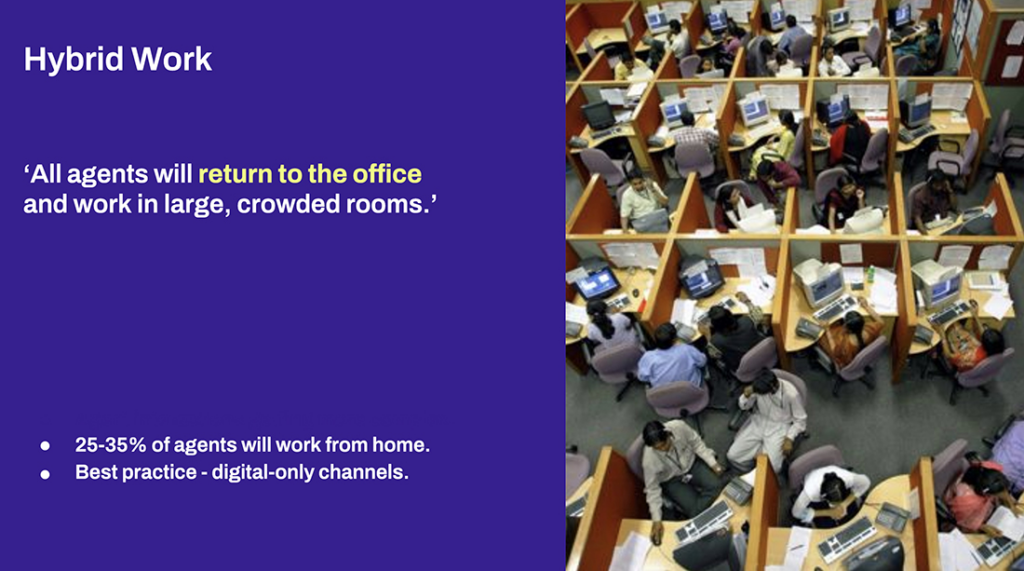What lies ahead for the fast-paced contact center market? Will enterprises need to deploy transformative technology or implement new processes in the coming months? Or will cloud-based platforms like Avaya’s continue to deliver significant advancements to customer service and support?
Blair Pleasanton, president and principal analyst, COMMfusion LLC, discussed the hype and the reality of current trends in a recent Enterprise Connect webinar, “Crazy Contact Center Predictions for 2022.” Ron Stevenson, senior product marketing manager for CCaaS, Dialpad. “We want to compare some crazy ideas with what will probably happen,” he said.
Here are five of those wild predictions with some real-world responses.

1. Empathetic bots and AI will take over. “Don’t hold your breath,” said Pleasanton. “AI will continue to augment human agents, not replace them. Organizations will benefit from having AI handle repetitive tasks so agents can focus on more complex interactions.”
However, there are plenty of ways that bots and virtual agents, with artificial intelligence and machine learning technologies, will help people be more productive and empathetic. For instance, chatbots using conversational AI can route callers based on keywords. “In a few years, bots will be able to understand customer sentiment and personality, and do routing based on those factors,” she said. “On the back end, agent assist tools provide suggested answers and resources to help people deliver faster and better answers to customers.
Pleasanton added that AI and natural language processing (NLP) technologies are now helping sales people close deals. “This will expand to the entire customer journey,” she predicted.
2. Self service will read a customer’s mind. While AI continues to improve, it’s a long way from handling every aspect of a customer interaction, according to Pleasanton. However, self service tools will grow in importance, because they allow customers to get information 24/7 without having to talk to an agent. In that regard, NLP technology will help callers get to the right information more quickly.
“I think about 20 percent of conversations can be handled by self-service by the end of 2022,” Pleasanton said. “That will lower overall costs for contact centers, and benefit customers who don’t have to spend time waiting on hold.”
3. People will call a contact center only because they are lonely. While contact centers have focused on meeting the world’s evolving digital communication requirements, voice is still the number one interaction channel, said Pleasanton. So, customers still need to be given a choice about their interaction channels. “When sharing documentation or photos, email might be the most efficient channel, and at 2 am, maybe a chatbot is best,” she added. “But don’t sacrifice quality voice service for expediency, and be sure callers can escalate to an agent.”
4. Customers wont mind waiting on hold. That’s not happening now or in the future, said Pleasanton. Use workforce optimization or workforce engagement tools to have the appropriate level of staffing in the contact center. “AI tools can help in predicting call volume,” she added. “You can also use predictive tools to give agents flexibility in their scheduling, especially in a work-from-anywhere setting.”
5. All contact center agents will come back to the office. Pleasanton expects the majority of contact centers to offer hybrid or part-time work-from-home scheduling for the foreseeable future. She cited a study showing that only about 4 percent of today’s agents want to go back to a contact center full time. “One best practice is to have office agents focus on voice calls, as there will be no worries about background noise or lack of bandwidth in the home setting,” she added.
Reflecting on current trends, Pleasanton added that organizations need to empower their agents, giving access to subject matter experts or AI tools that help them provide better customer service. “AI can make their jobs more interesting, increasing retention and agent morale,” she said. “When agents enjoy their work, they will make callers feel good about their customer journeys.”
